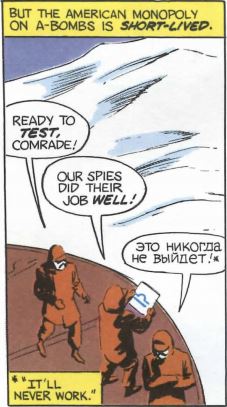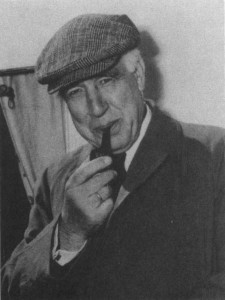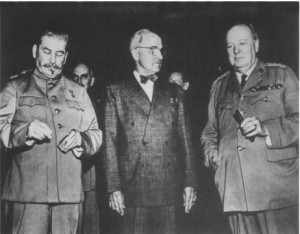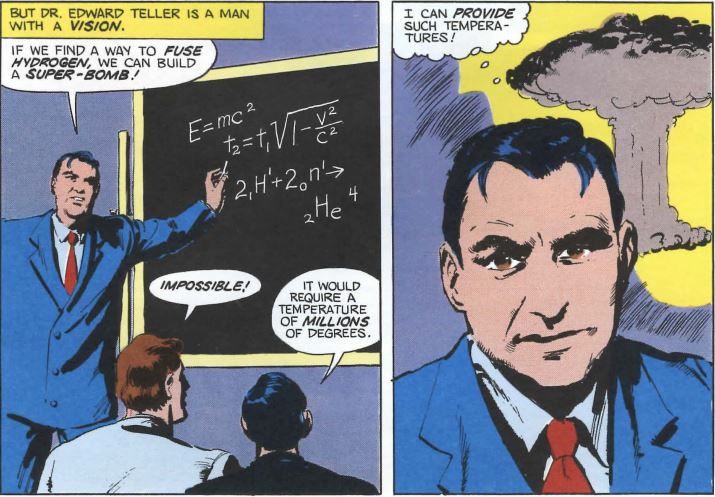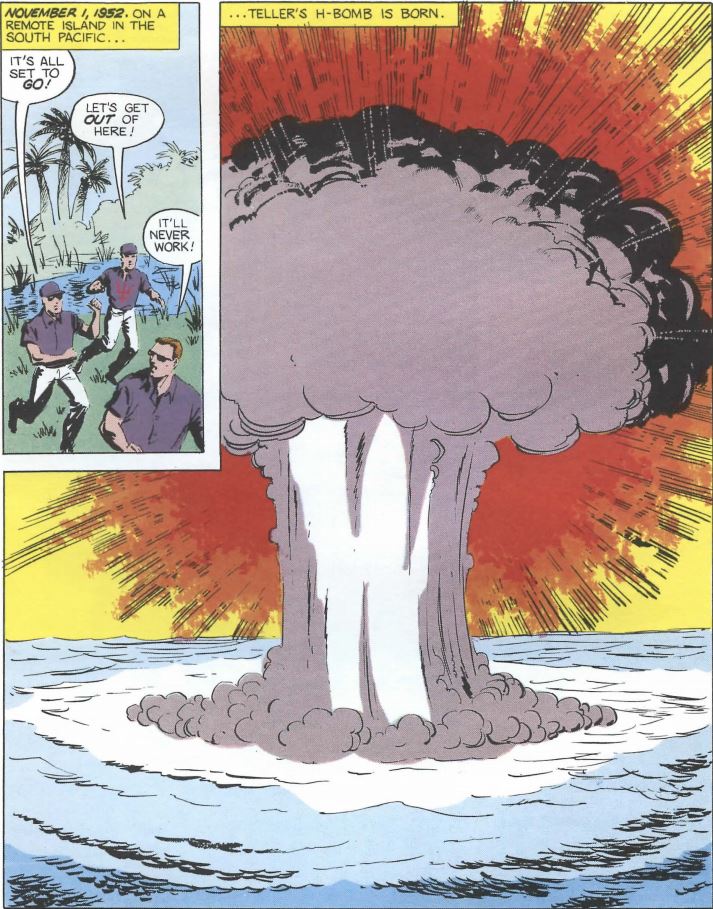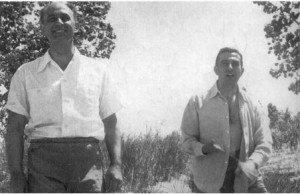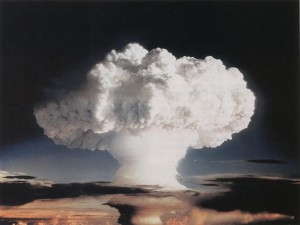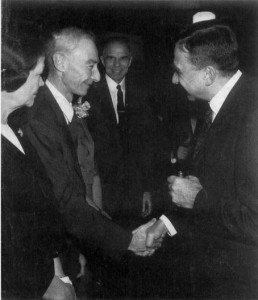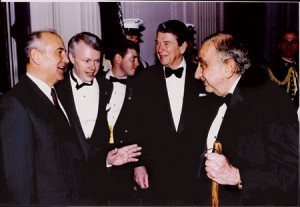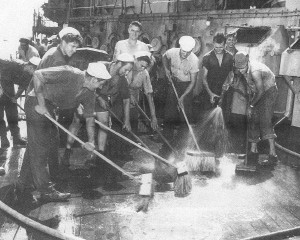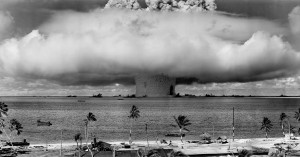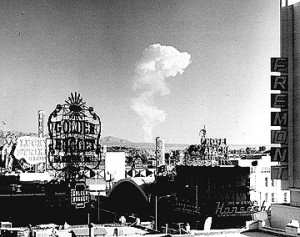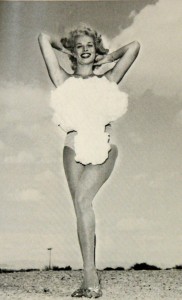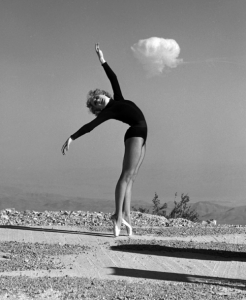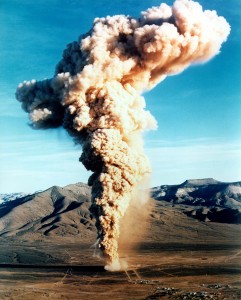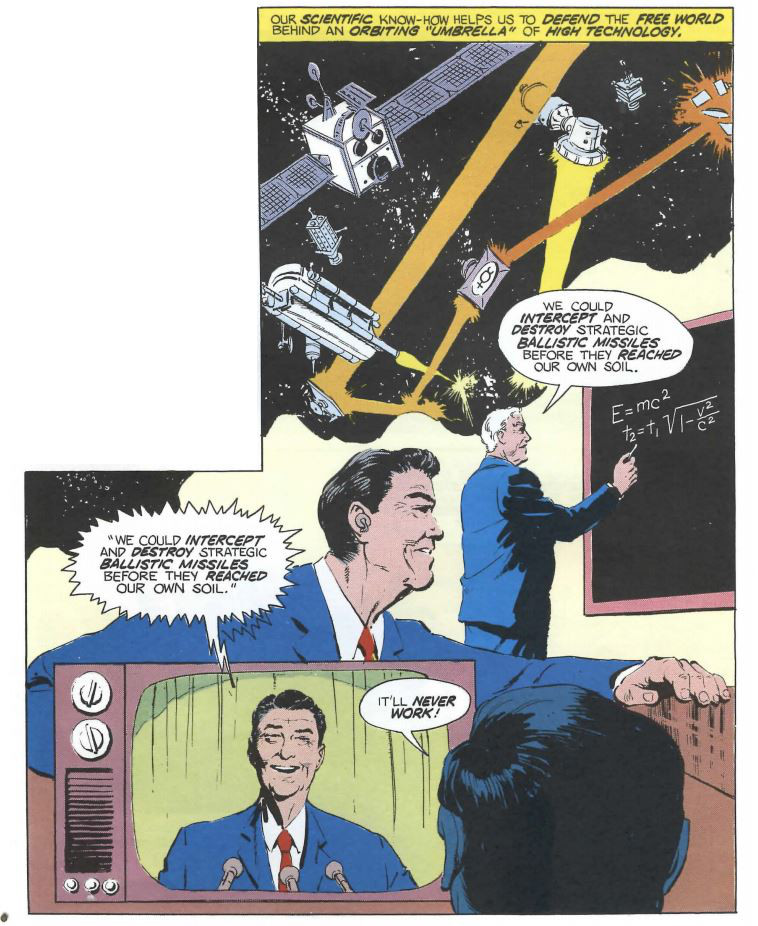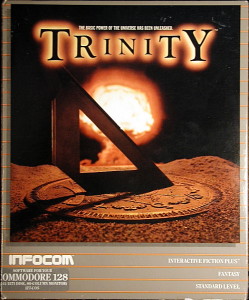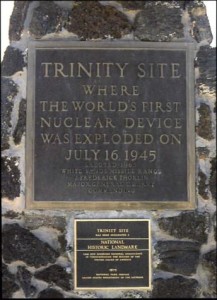Platform
This narrow platform is attached to the north side of a huge steel enclosure, fifty feet high. All around you, a frozen wasteland stretches off to a horizon lined with gray mountains.
A loudspeaker barks, "Sorokpyat sekund."
>d
You descend the ladder.
Under Platform
A network of cables snakes down the side of the enclosure, then trails southwest across the tundra. Grim tracts of permafrost greet your eyes every way you turn.
A ladder leads up to a platform overhead.
A loudspeaker intones, "Treetsat sekund."
Something touches your sneaker.
You kick it away with a shout. A rodent sails through the air, lands unharmed and scrambles out of sight.
>ne
Tundra
A prehistoric river bed cuts a narrow pass through the mountains rising north and east. The enclosure is a gray sentinel on the southwest horizon.
The ground is covered with rodents! They're racing northeast, oblivious to you or anything else in their path.
"Pyatnatsat sekund."
>ne
You follow the stream of rodents.
Cliff Edge
The river bed ends here, on a cliff overlooking an Arctic sea. But where ancient waters once fell, there now pours a living stream of rodents. Driven by mindless instinct, too stupid or frightened to turn away, they plunge by the hundreds into the crashing waves below. You recognize the species now. Lemmings.
The ground underfoot is split by a narrow fissure, almost hidden by the scrambling lemmings.
"Pyat, chetirye, tree, dva, adeen," barks the loudspeaker.
A searing glare engulfs the mountaintops! You turn, and stare in horror at a seething mass of flame billowing above the tundra.
Seconds later, a gale of radioactive debris sweeps you over the edge of the cliff, where you founder for a while in the Arctic waters.
On August 29, 1949, the Soviet Union tested its first atomic bomb at what would soon become known as the Semipalatinsk Test Site, in a remote area of the Kazakhstan steppe. Although the successful test was not immediately announced, the radiation it produced was detected by one of a cordon of spy planes that patrolled the edge of the Kamchatka Peninsula. President Truman rather than General Secretary Stalin thus became the first to tell the world on September 23: “We have evidence that within recent weeks an atomic explosion occurred in the U.S.S.R.” The Soviet Union soon gloatingly confirmed the test, and the world shuddered. The era of mutually assured destruction had just begun.
Looking back on the event from today, we might be tempted to ask whether it had to be this way, whether there were things the West could have done during its brief era of nuclear monopoly to assure that the world didn’t get plunged into a seemingly irresolvable stand-off whose only realistic end point would seem to be nuclear war. Or, conversely, was the history we got a pretty lucky one considering some of the alternatives? Or is the whole debate moot because the course of history is driven by bigger forces than the individual actors strutting and fretting their hours on its stage — or simply because what will be will be, the course of history inevitable? Those are some profound questions, involving, depending on how you approach them, historiography, philosophy, psychology, even religion. They certainly aren’t questions I pretend to be able to answer for you here. Yet it might be important to ask them and to think about them, not least because I think it might help us to better understand Trinity‘s own view of history.
The period immediately after the end of World War II in the United States wasn’t quite the undilutedly joyous homecoming that the more sentimental popular histories of that time might make you think. The economy went through a brief but wrenching dislocation as the United States transitioned back from what had amounted to socialism in the name of maximal military production during the war years to consumer-driven civilian capitalism. And many women who had found unprecedented opportunities and responsibilities outside the home during the war must have felt at least a bit wistful when the men all returned and they found themselves back in their proverbial kitchens. But most of all there was a deep sense of uncertainty about the world the war had wrought. How would the United States and the Soviet Union, suddenly staring into each other’s eyes from either side of a bifurcated Europe, get along? What did the atomic bomb mean for that relationship, for the future in general? Journalist Edward R. Murrow, the veritable voice of the Greatest Generation, sounded a note of worried confusion rather than triumph during his broadcasts from this period: “Seldom if ever has a war ended leaving the victors with such a sense of uncertainty and fear, with such a realization that the future is obscure and survival is not assured.”
The end of a major war is always a fertile time for utopianists looking for a way to ensure that another one never starts. In the historical timeline we know, World War II begat the United Nations, an imperfect collective which, if it hasn’t quite ended war, has done what it could over the years and has at least managed to be markedly more successful and long-lived than the League of Nations that preceded it. Many at the time, however, had in mind much more than a meeting place for the diplomats of the world, as useful as that’s occasionally proved to be. A major movement was in fact afoot, prompted largely by the atomic bomb and its implications, for nothing less than a world government.
In 1946 a little 86-page collection of essays with a big title appeared on bookstore shelves: One World or None: A Report to the Public on the Full Meaning of the Atomic Bomb. Many of its essays advocated turning the United Nations into the legislative branch of a new government to have sovereignty over all the nations of the world. The contributors who wrote the essays were hardly the bunch of anti-establishment dreamers you might expect. They included some of the most prominent scientists on the planet, including many — among them Niels Bohr, Robert Oppenheimer, and Leó Szilárd — who had worked as part of the Manhattan project to build the bomb in the first place. Also among the contributors were Hap Arnold, commander of the Army Air Force during the war, and Walter Lippmann, a prominent journalist who would go on to coin the phrase “Cold War.” Other public supporters of the book and the world-government movement that had spawned it included the president of Standard Oil of Ohio and the chairman of the National Association of Manufacturers, along with Senators, Congressmen, Supreme Court Justices, even current Army Air Force commander Carl Spaatz. The book became a bestseller. A few months after its release, a poll found that an astonishing 54 percent of the American public wanted the United Nations to become a world government with sovereignty over the United States as well as everyone else.
As the title of its manifesto would imply, the one-world movement saw the atomic bomb in mythic terms, destined to be either humanity’s savior or its downfall. This vision of a post-atomic utopia as the only alternative to extinction can be traced back to The World Set Free, a 1914 novel by H.G. Wells which posits not only nuclear weapons but a world government as the only rational response to their existence. This new government “had to see the round globe as one problem; it was impossible any longer to deal with it piece by piece. They had to secure it universally from any fresh outbreak of atomic destruction, and they had to ensure a permanent and universal pacification.” Science, Wells wrote, must provide “the basis of a new social order.” How appropriate, then, that the one-world movement included so many scientists in its ranks. While Wells provided it with its broad outlines, it was one of these scientists who first drilled down to grasp the full implications of the historical atomic bomb. In the process, he became the first to understand, or at least to articulate, the doctrine of mutually assured destruction that must follow from it. This scientist was Niels Bohr.
Born in 1885 in Copenhagen, Denmark, Bohr had become by the 1930s as important and brilliant a physicist in his way as Albert Einstein. His most obvious among countless contributions was the so-called “Bohr Model” of the atom: protons and neutrons clustered into a central nucleus, electrons orbiting in neatly predictable clusters (“energy levels”). But just as important as his own work was his founding of the Institute of Theoretical Physics at the University of Copenhagen in 1920. It became during the inter-war years the foremost gathering point for physicists from all over Europe and the world. Coincidentally or not, this period was perhaps the most fertile in the history of the field, marked by a whole series of quantum leaps (sorry!) in our understanding of the basic structures of the universe. Bohr knew everyone and was respected and liked by just about everyone, not just for his scientific genius but for a certain fundamental humanity that he was about to demonstrate to the world.
He was aboard a ferry returning to Denmark from a lecture tour to Norway when Germany invaded both countries early on the morning of April 9, 1940. Denmark surrendered within a few hours. As such a prominent figure, and one whose scientific genius could very well make him valuable to the war effort, Bohr was soon contacted by British agents bearing an offer to sneak him away to exile. But Bohr, like the Danish King Christian X, declined, saying his place was here with his people.
Initially, the German occupation wasn’t that bad as such things go. In return for a promise to behave themselves reasonably well and to produce food sufficient to feed many millions of German soldiers and civilians from the fertile soil of Jutland, Denmark was granted a level of autonomy and freedom unique amongst the occupied countries — a situation born not only of Germany’s need for the food Denmark could supply but also the country’s decision to surrender without a fight and Nazi racial theories that placed the Danes, being a Germanic people, only one rung or so down the ladder from the Germans themselves. Bohr himself, again like Christian X, took a principled but pragmatic stance, never hesitating to denounce the occupation and refusing to participate in any conference or other activity which involved the occupiers, but not actively resisting either.
After having dismissed an atomic bomb as possible only if “you turned the United States into one huge factory,” Bohr learned that others were less sanguine through a very surprising source. In September of 1941, Werner Heisenberg, the German physicist who had touched off the whole debate with his discovery of nuclear fission, came to Copenhagen, where he had a long conversation with his old friend, mentor, and confidant Bohr. Heisenberg was now conducting experiments with chain reactions in heavy water aimed at synthesizing plutonium for a potential atomic bomb. Speaking in circumspect terms, mindful of the Nazi ears that could be anywhere, Heisenberg shared the gist of his current research. We’ll never know exactly why he decided to open the topic with Bohr, who, old friend though he may have been, made no secret of his opinion of Nazi Germany. Was he, as his wife Elisabeth would later claim, suffering a crisis of conscience and reaching out for moral wisdom from his erstwhile mentor? Was he trying to tell Bohr that a Nazi atomic-bomb program was underway, in the hope that Bohr might be able to pass that information along to Britain? Or was he hoping to learn what if any research was going on in the other camp? To further muddy these waters, Heisenberg actually gave to Bohr a diagram of one of his heavy-water reactors, an act which would have been punishable as treason — if, that is, it wasn’t a planned act of counterespionage. Regardless, both men came away from the meeting unsatisfied, Bohr disappointed and angry that a former protege would contemplate creating such a terrible weapon for such an evil regime, Heisenberg having comprehensively failed to get the understanding and information — whichever, or both — he sought. The only thing the meeting accomplished was to make Bohr very nervous about the prospect of an atomic bomb.
But soon Bohr had more immediate worries. As the Danish resistance movement, feeling increasingly emboldened in response to Germany’s strategic setbacks over the course of 1942 and 1943, got more active, Denmark’s cushy arrangement with its occupier grew more and more fractious. At last, on August 29, 1943, the occupiers dissolved the Danish government and instituted martial law. Bohr was informed soon after by Denmark’s ambassador from Sweden that he was slated to be arrested. Underground fighters hid him and his family in a shed near Copenhagen’s pier until a boat could be sneaked in under cover of night. Dodging minefields and German patrol boats on a windy, miserable night, they made it across the Øresund to neutral Sweden.
Bohr had made his own escape, but he was frantic with worry over another group. He had received word that Denmark’s modest population of about 8000 Jews were also slated to soon be rounded up and shipped off to concentration camps. Their only possible escape would be to follow in Bohr’s footsteps and come to Sweden. Unfortunately, the Swedish government, very nervous of angering the Germans and thus bringing their wrath down upon their own country, had refused them permission to enter. Almost through sheer force of will alone, Bohr won a personal meeting with the Swedish King Gustaf V, and persuaded him to put pressure on his Foreign Minister to accept Denmark’s Jews. Working in coordination, the Swedish Coast Guard, the Danish resistance, and countless ordinary Danes methodically spirited away the Jews with typical Scandinavian efficiency. When the Nazis came to round them up, virtually all of those Jews who weren’t already out of the country were well-hidden in preparation for the trip. More than 99 percent would survive the war. It makes for one of the most remarkable stories of the Holocaust, and one of the vanishingly small number that have a happy ending. The Danes are justifiably proud of what they were able to do to this day; it says a lot about them as a people. It also, of course, says a lot about what kind of man was Niels Bohr, without whose assistance it never could have happened.
With Denmark’s Jews now offered a safe harbor, Bohr was eager to get to Britain and learn what if anything had been going on in the field of atomic-bomb research. The British offered him passage aboard one of the fast two-man Mosquito fighter-bombers they were using to carry diplomatic messages to and from the isolated Swedish government. With no other space available, the crew stuffed Bohr into the Mosquito’s tiny bomb bay. If attacked, the pilot announced, he would have to drop Bohr into the North Sea to save weight for maneuvering. Bohr was given a parachute and signal flare, but was highly unlikely to live more than a few minutes in that frigid water. Although the Mosquito made it back to Britain unmolested, Bohr failed to put on his oxygen mask properly and fainted en route. Once back on land again, however, he was none the worse for wear. By the end of 1943 he had completed his odyssey, arriving safely in Los Alamos.
He found there some of the greatest scientific minds of the generation, many of them his former colleagues, students, and/or friends, all well about the practical business of making an atomic bomb. He could now share with them at last the diagram Heisenberg had passed to him more than two years before. The design it depicted was so inefficient, so far behind those the Manhattan Project had constructed, that many thought it must indeed be a counterespionage ploy. Otherwise, as Bohr himself later said, Robert Oppenheimer and his colleagues “didn’t need my help in making the atom bomb.” He instead made an intellectual leap in another realm entirely, a leap as dazzling as the one that had led to the Bohr Model of the atom. While at Los Alamos, Bohr said something positive but also ambiguous to Oppenheimer. Nothing like the massive conflict still raging in Europe and the Pacific would, he said, “ever happen again.” Even the perceptive Oppenheimer initially missed the full impartation of this statement.
Bohr meant it literally. Total war between great powers as the world had come to know it over the centuries simply could not happen in a post-atomic world because no one would be able to win. This didn’t mean that war of another sort would be impossible; one nation could attack another, or two could attack one another. However, the result would not be an extended struggle ending with a victor standing proud, but merely a short orgy of unimaginable destruction ending with two smoking losers. The atomic bomb was far, far more than just a new weapon. It would be the ultimate leveling force amongst nations, capable of reducing all of them to identical smoking ruins, “a far deeper interference with the natural course of events than anything ever attempted.” The very survival of civilization therefore required that war itself must be not a universal but a historical phenomenon. If war was, as Carl von Clausewitz had once so famously said, “the continuation of politics by other means,” this means of politicking was about to go off the table. “We are in a completely new situation that cannot be resolved by war,” said Bohr. The choice was not now between peace and war but between peace and guaranteed self-destruction. The major powers were about to enter a stalemate from which victory would be impossible. They could continue to jockey pointlessly for advantage, risking mutual annihilation all the while, or they could… what? That was the question.
“It appeared to me,” Bohr writes, “that the very necessity of a concerted effort to forestall such ominous threats to civilization would offer quite unique opportunities to bridge international divergencies.” There must be “a universal agreement in true confidence” to ban the atomic bomb and to ban all future war. Any such agreement would bring with it an important corollary: because nations were hardly likely to simply trust one another on a matter as deadly as the atomic bomb, there must also be an end to state secrets. As Oppenheimer would later express it, “Everything that might be a threat to the security of the world would have to be open to the world.” “What it would mean,” said Bohr, “if the whole picture of social conditions in every country were open for judgment and comparison need hardly be enlarged upon.” Could characters like Hitler and Stalin commit their genocides in such conditions?
Bohr’s logic was essentially that the atomic bomb was about to change everything anyway, whether we liked it or not. By planning for the atomic future we could make of that change a positive historical development rather than the potential end of civilization. As the country about to become the first with access to the bomb, the United States had the opportunity and the duty to initiate the process that could lead to this better world order by talking openly about this new power, inviting the world to join in the dialog. The “secrets” of the atomic bomb that the United States believed it possessed were merely trade secrets, technical secrets; the fundamental physics that had made its creation possible were accessible to the world. Thus the American atomic monopoly was destined to be a very short one. But what the country did while it had that monopoly, Bohr claimed, could cast the die for the next hundred years or more — indeed, could determine whether civilization itself lived or died.
Bohr’s stature was sufficient to win him separate meetings with American President Franklin Roosevelt and British Prime Minister Winston Churchill to argue his case in 1944. The meeting with Roosevelt turned into little more than a noncommittal formality. The meeting with Churchill, on the other hand, was a disaster. The irascible Churchill, preoccupied with final preparations for the D-Day invasion, had little interest in being lectured to on the vagaries of geopolitics by a pedantic Danish physicist. The styles of the two men did not, to say the least, mesh. Bohr had a way of circling around and around his points that could infuriate even his admiring students and coauthors; he liked to say that accuracy and clarity were complementary — “and so, a short statement could never be precise.” Churchill failed to grasp anything that Bohr tried to tell him. “I cannot see what you are talking about,” he said. “After all this new bomb is just going to be bigger than our previous bombs. It involves no difference in the principles of war.” His main takeaway from the meeting seems to have been that Bohr wanted the Western Allies to immediately turn over the bomb to the Soviet Union as well as anyone else who wanted it, when in fact Bohr was just asking them to initiate an open preliminary discussion about the bomb and what it meant for the world. After half an hour — half the scheduled time — Churchill all but threw Bohr out on his ear. He soon after wrote a memo saying that Bohr should be closely watched, and consideration even given to “confining” him to make sure he didn’t commit “mortal crimes” — presumably in the form of an attempt to give the bomb to the Soviets of his own accord.
Churchill’s reaction certainly isn’t impossible to understand. He still had this war to fight, after all. And Bohr’s plan wasn’t necessarily the most practical. It does have that distinct whiff of the utopian about it, an odor that a practical politician like Churchill would have learned to detect and detest many years ago. Parts of the argument do rather sound like a scientist trying to impose a rigid frame of cause-and-effect logic on complicated, messy international affairs that just won’t admit one. Still, one wishes Bohr could at least have been able to get Churchill or Roosevelt to think about the implications of his greatest insight: the still-in-the-offing but unavoidable prospect of MAD. As it was, neither man seems to have remarked the concept at all, lost as it was in Bohr’s typical sea of verbiage. Almost as depressing is Churchill’s immediate leap from “advocate for reasoned diplomacy with the Soviet Union” to “traitor”; this exact fallacy would ruin many lives over the course of the Cold War to come. Bohr — a great, even heroic man, whatever the practical failings of some of his ideas — spent the rest of the war trying fruitlessly to get further meetings with either leader. He had saved Denmark’s Jews from the Holocaust, but he couldn’t save the world from the Cold War.
Or, better said, he couldn’t do it alone. Ideas, if repeated often enough, have a way of spreading themselves around. By 1945, Bohr’s ideas were, as nuclear historian Richard Rhodes puts it, “in the air” in both Washington and Los Alamos. Vannevar Bush and James Bryant Conant, Roosevelt’s two closest science advisers, expressed concern as the fateful day of the first test neared that it was dangerous to assume that the United States’s atomic monopoly could possibly last for very long. If Roosevelt’s government didn’t talk to the Soviets about it before using it, it could lead “to a very undesirable relationship indeed on the subject with Russia.” Showing some prescience of their own, they imagined that someday atomic bombs might be able to reach all the “cities of the world” from anywhere in the world via a “robot plane or guided missile.” They proposed that the United States initiate a dialog which could lead to the formation of an “international office” to share and regulate the secrets of the atom: “We recognize that there will be great resistance to this measure, but believe the hazards to the future of the world are sufficiently great to warrant this attempt.” Robert Oppenheimer also said that the time may be right to “open up this subject” with the Soviet Union “in a tentative fashion.”
After Roosevelt’s death in April of 1945, his and his successor Harry Truman’s war-hating Secretary of War Henry Stimson, who had personally overseen the Manhattan Project from its beginning, made a much more forceful statement, saying that as the inventor of the atomic bomb the United States would bear “a certain moral responsibility” for any “disaster to civilization which it would further.” Thus the country had a moral imperative to try to arrange a world order which could avert such a disaster, via a “world peace organization” which could eventually be entrusted to “share” the atomic bomb with everyone. No less a military mind than Army Chief of Staff George Marshall said it might be a good idea to invite a Soviet delegation to get an overview of what had been done at Los Alamos and to witness the upcoming Trinity test.
It’s of course impossible to say how Roosevelt would have reacted to such advice from two of his oldest and wisest friends. Certainly it’s much harder to accuse them than Bohr of political naiveté. The new President Truman, however, was very much under the sway of his new Secretary of State Jimmy Byrnes, who would become one of the early architects of the country’s Cold War posture, pushing for a hardline, take-no-prisoners approach to the Soviet Union. Told of the atomic bomb’s massive destructive potential, Byrnes was not disturbed but delighted, saying it would greatly improve the United States’s negotiating position with the Soviet Union, that a forceful “demonstration of the bomb” in action — in the form of its being unexpectedly dropped on Japan — “might impress” the un-forewarned Soviet Union. At the Potsdam Conference just eight days after the Trinity test, Truman mentioned almost offhandedly to Stalin that the United States had developed “a new weapon of unusual destructive force”; that was as far as all of the suggestions for a dialog with the Soviet Union would ever stretch. Stalin, who knew all about the Manhattan Project’s existence thanks to his espionage network and knew perfectly well that it was more than just “a new weapon,” almost smirked visibly at this confirmation of his supposed ally’s perfidy: “He said he was glad to hear it and he hoped we would make ‘good use of it against the Japanese.'” Both men then dismissed the topic. With the last war not yet over, a new standoff was already beginning. Would it be an intractable one? That’s a question much of the world would soon be asking.
Truman may have squandered his first and best opportunity to really talk with the Soviets about the bomb, but well before Japan’s surrender was a year old the voices calling for international controls became too loud and popular for a seasoned politician like him to ignore. So, like any seasoned politician, he hedged his bets. Even as the Navy was assembling a fleet of ships to be blasted by atomic bombs at Bikini Atoll as a blunt demonstration of the United States’s new military might, he sent a patrician financier and longtime policy adviser named Bernard Baruch to the United Nations to explore the formation of a United Nations Atomic Energy Commission. “We are here to make a choice between the quick and the dead,” Baruch announced to the assembled delegates. “We must elect world peace or world destruction.” He offered a plan that would place the United Nations in control of “all atomic-energy activities potentially dangerous to world security,” with the power to inspect all nuclear facilities and punish anyone found to be attempting to make weapons. The Soviets, not in a good humor after the Bikini tests, replied that the Americans should begin by destroying all of their own atomic bombs as a sign of good faith, and negotiations quickly reached an impasse from which they would never emerge. The Soviets’ undisguised mistrust of American intentions was part and parcel of an ever-widening gulf between the world’s two remaining superpowers that would soon make dreams of worldwide arms control and world government sound as quaint as… well, as quaint as they sound to our ears today. Meanwhile the atomic bomb was becoming, almost in spite of itself, an increasingly vital part of the United States’s strategic picture.
The problem was one of conventional-force disparity. When the forces of the Western and Eastern Allies had met one another in the middle of Germany at the close of the war, they had been roughly equal. Now, though, the Americans and British were coming home by the millions, leaving behind their rifles and their uniforms and returning to lives as business executives, shopkeepers, and farmhands. Meanwhile the Soviet Union, a centralized economy driven largely by military spending which had no private jobs to which to return, wasn’t demobilizing to anywhere near the same degree. And Stalin was reneging on all of his promises to allow the countries of Eastern Europe free determination, bringing down an “Iron Curtain” — the term was popularized by Winston Churchill in a speech on March 5, 1946, ironically at almost the same moment as the publication of One World or None — across the middle of Europe. The stage was thus set for a stand-off that would last more than forty years, the democratic peoples of the West staring down the totalitarian nations of the East. The West had no hope of matching Soviet numbers in Europe unless it was willing to keep most of its young men in arms for terms of as much as eight or ten years each. This the civilian societies of the West, eager to rebuild and enjoy the fruits of the hard-fought peace, had no interest in doing. Thus by 1947 Soviet armies in Europe outnumbered Western by as much as ten to one. But there was a great equalizer: the atomic bomb.
Indeed, some believed the atomic bomb should be more than a mere equalizer, should be used to solve the problem in a more direct way. As relations worsened with the Soviet Union and the clock ticked down to the inevitable reality of a Soviet bomb, the pendulum of public sentiment swung wildly in a new direction. A public that just a year before had been dreaming of a peaceful world-government utopia now began to seriously mull the notion of a preemptive nuclear strike. It would be a painful undertaking, strike proponents said, but it had to be done now, before the Soviets had atomic bombs of their own. Some of the hawkish voices were those of respected military men, like General Leslie Groves, who had built the Manhattan Project from the ground up, and General Orvil Anderson, who thought nuclear war would be the most Christian thing to do at this juncture: “I think I could explain to Him that I saved civilization.” The dogged old warrior Churchill reminded everyone how well appeasement policies had worked against Hitler, and advocated an ultimatum: pull out of all of the countries you’ve occupied and give to them the right of self-determination you promised them or prepare to be nuked. Other voices advocating preemptive nuclear war were more surprising. The great British philosopher Bertrand Russell, whose pacifism had led to his imprisonment during the First World War, was among them, as was Hamilton Holt, just a year before the organizer of a major world-government conference. World government in his view should now entail that any nation that attempted to develop atomic bombs, as the Soviet Union obviously was, “should be wiped off the face of the earth” by the United Nations with a taste of its own medicine. (The role and fate of the United States, still the only nation actually in possession of atomic bombs, was unclear in this formulation.)
Thankfully, such voices didn’t get their way before August 29, 1949, made the point moot. There could be no preemptive strikes on a Soviet Union in possession of a bomb of its own. With the Soviet bomb ended this crazy few years when the direction of history seemed a veritable smorgasbord of divergent possibilities, some wonderful, some terrible. Now the world must settle in for the long, tense, grinding nuclear stalemate of the Cold War, and the United States must exchange dreams of world government for paranoid communist witch hunts.
Looking back at that crossroads of history of 1945 to 1949, we’re left to wonder whether it all could somehow have turned out differently. Could some great leader willing to really listen to what Bohr and all those who followed him were saying have harnessed the idealistic fervor of the world-government movement, and in so doing changed the course of history as we know it? If Roosevelt had lived longer, would he have been that leader, or would he have pretty much done what Truman did? Was there any real possibility for a peace not founded on threats in a world that contained the paranoid maniac Stalin, just possibly the most prolific mass murderer in the history of the world? These aren’t questions I can answer for you; you’ll have to ponder them on your own. Perhaps, given the situation at the end of World War II, the Cold War really was inevitable. Perhaps any more earnest attempt to prevent an arms race and/or institute international controls on nuclear weapons would have merely ceded the advantage to the Soviet Union and resulted in a Soviet first strike (Stalin, alone among the Soviet General Secretaries, strikes me as just possibly crazy and genocidal enough to do it if he thought he could get away with it).
For its part, Trinity takes the tragic view of history. Its attitude toward the Cold War and the societies it involved is summed up in the extract that opened this article: a horde of lemmings running pell-mell toward their destruction, “too stupid or frightened to turn away” — certainly not one of the game’s more subtle examples of symbolism but nevertheless one of its most striking and effective. Less impressive is Trinity‘s recreation of the actual scene of that first test, which it gets thoroughly wrong; the actual test took place on the landlocked steppes of Kazakhstan, nowhere near the Arctic Ocean. One must assume that Brian Moriarty’s research simply failed him for this, the only scene in the game that shows the Soviet side of the Cold War. The larger point of the scene, however, stands. Trinity postulates that the inevitable end point for the lemmings of the world is an apocalyptic fall off of an unthinkable nuclear cliff. So far — fingers crossed! — that hasn’t happened. I admire Trinity greatly, but I hope that history continues to prove it less than prescient in this regard.
